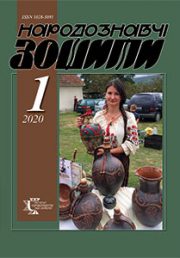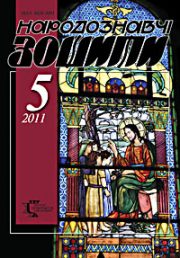2020 #6 Ivannikova L.
The Ethnology Notebooks. 2020. # 6 (156), 1314—1327
УДК 398.2/5/8:930.24+394.012
DOI https://doi.org/10.15407/nz2020.06.1314
Lіudmyla IVANNIKOVA
- ORCID ID: https://orcid.org/0000-0003-0617-5082
- Dr. Philology, Senior Scientific Worker,
- Rylsky Institute for Art Studies, Folklore and Ethnology,
- Ukrainian National Academy of Sciences,
- 4, Hrushevskoho str., 01001, Kyiv, Ukraine
- e-mail: ivannikovafolk@ukr.net
FOLKLORE DISCOURSE OF EUROMAIDAN (2013—2015): VIEW FROM THE INSIDE
The purpose of the article is to show the stretch of the tradition of creating various forms of protest folklore and represent their own observations on the folk process at the bottom of the dignity revolution. Materials to it were fixing of verbal and verbal-visual texts, made in the period from December 2013 to April 2014 and in February 2015 р. On the Independence Square in Kyiv and the streets adjacent to it: Hrushevsky, Institutskaya, Khreshchatyk.
These are photo fixations of verbal and verbal-visual texts made by the author during the Revolution of Dignity in Kyiv. That’s more than 4000 photos. Various genres of protest folklore are recorded on them. These are slogans, kolomyyki, monograph verses, revolutionary graffiti, etc. That was the work of political technologists, and the works of professional and amateur poets and artists, and the work of protesters. This material makes possible to trace on the dynamics of the folklore creative process of the history of revolution .
Verbal and visual folklore forms, oral and written forms of communication have always existed in parallel in the traditional folk culture. Since the early 90’s of XX century verbal-visual texts and oral small folklore forms with political content have become widespread. The slogan became the most productive folklore form. The author points out the main features which testify to the affiliation of these texts to the folk tradition. These are anonymity and collective creation and performance, oral/ visual distribution, formulaic origin, presence of numerous variants (oral and written), extreme emotionality, actualization of long-forgotten folklore samples, chants and travesties of famous popular songs and poems, using of traditional forms, plots, images. The author of the article makes interesting observations about the process of creation and functioning during the revolution of various folklore genres: songs, slogans, poems. The participants of the revolution were active creators and performers of protest folklore. The whole Euromaidan folklore can be divided into two huge blocks: living among the protesters and the folklore on the stage. This article is devoted to the description and analysis of these processes.
The discourse of the scene, which, in turn, was divided into copyrights (songs of well-known rock performers, songs that arose directly at the bottom of the revolution, the songs of the UPR, parody on famous songs) and folk songs (Kolomyki which were performed by Irena Karpa, bands “Taruta” and Folkners, Duma, Church songs and psalms, humorous, Applying, Cossacks, Small, Insurgent songs performed by the group “Ruthenia”), etc. The consolidating role played an hourly performance of the national anthem “Ukraine” and joint prayer.
The methodological basis of the article are the principles of systemicity, historicism and comparative with the use of cultural and historical and comparative-typological methods.
Keywords: Maidan folklore, protest folklore, political folklore, slogan, poster, revolutionary graffiti, verbal-visual text.
REFERENCES
- Voronyuk, L. (Ed). (2014). Heavenly Hundred: an Anthology of Maidan Poems. Chernivtsi: Bukrek [in Ukrainian].
- Orlova, Yu. (2014). 111 days of the Maidan. Notes of a Kyiv-woman. Kyiv: Duliby [in Russian].
- Trach, N. (2015). «Together is power!»: Rhetoric of Ukrainian Resistance. Sociolinguistic essays. Kyiv: Clio Publishing House [in Ukrainian].
- Kovtunovich, T. & Pryvalko, T. (Eds.). (2016). Maidan in the first person. Art on barricades (Issue 2). Kyiv [in Ukrainian].
- Chebanyuk, O. & Kovaleva, O. (Eds.). (2019). Maidan. Direct Speech (Book 1). Kyiv: National Museum of the Revolution of Dignity [in Ukrainian].
- Zakharova, A. (2013). The Fruits of Euromaidan’s Work (Anecdotes, Wrappers, Songs). Retrieved from: https://ukraine.segodnya.ua/ukraine/plody-tvorchestva-evromaydana-anekdoty-fantiki-i-pesni-485740.html [in Rusian].
- Horishnya, G.M. (2018). Poetry of the Maidan in the Ukrainian Revolutionary Poetry Discourse of the XX—XXI century. (Dr. philology diss. abstr.). Ternopil [in Ukrainian].
- Efremov, S.O. (1997). Diaries. 1923—1929. Kyiv [in Ukrainian].
- Pashchenko, E. (Ed.) (2008). Ukrainian Political Folklore. Kyiv [in Ukrainian].
- Pashchenko, E. (Ed.) (2017). Oral Political and Erotic Art (in the records of 1920—1940). Kyiv [in Ukrainian].
- Borysenko, V. (2007). Memory Candle: an Oral Story about the Genocide of Ukrainians in 1932—1933 (Pp. 66—69). Kyiv: Stylos [in Ukrainian].
- Vyshnya, Ostap. (2014). «My thoughts, my thoughts» (Diary notations). In Galchenko, S.A. History of the Text. Source Studies and Textological Aspects of the Tychyna’s, Sosyura’s, Ostap Vyshnya’s works (Pp. 611—612). Kyiv: Naukova dumka [in Ukrainian].






